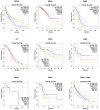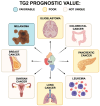The Role of Transglutaminase 2 in Cancer: An Update
- PMID: 38474044
- PMCID: PMC10931703
- DOI: 10.3390/ijms25052797
The Role of Transglutaminase 2 in Cancer: An Update
Abstract
Transglutaminase type 2 (TG2) is the most ubiquitously expressed and well characterized member of the transglutaminase family. It is a ubiquitous multifunctional enzyme implicated in the regulation of several cellular pathways that support the survival, death, and general homeostasis of eukaryotic cells. Due to its multiple localizations both inside and outside the cell, TG2 participates in the regulation of many crucial intracellular signaling cascades in a tissue- and cell-specific manner, making this enzyme an important player in disease development and progression. Moreover, TG2 is capable of modulating the tumor microenvironment, a process of dynamic tissue remodeling and biomechanical events, resulting in changes which influence tumor initiation, growth, and metastasis. Even if generally related to the Ca2+-dependent post-translational modification of proteins, a number of different biological functions have been ascribed to TG2, like those of a peptide isomerase, protein kinase, guanine nucleotide binder, and cytosolic-nuclear translocator. With respect to cancer, TG2's role is controversial and highly debated; it has been described both as an anti- and pro-apoptotic factor and is linked to all the processes of tumorigenesis. However, numerous pieces of evidence support a tissue-specific role of TG2 so that it can assume both oncogenic and tumor-suppressive roles.
Keywords: breast cancer; colorectal cancer; leukemia; lung cancer; melanoma; microenvironment; ovarian cancer; pancreatic cancer; transglutaminase 2.
Conflict of interest statement
The authors declare no conflicts of interest.
Figures










Similar articles
-
The Outside-In Journey of Tissue Transglutaminase in Cancer.Cells. 2022 May 29;11(11):1779. doi: 10.3390/cells11111779. Cells. 2022. PMID: 35681474 Free PMC article. Review.
-
Physiological, pathological, and structural implications of non-enzymatic protein-protein interactions of the multifunctional human transglutaminase 2.Cell Mol Life Sci. 2015 Aug;72(16):3009-35. doi: 10.1007/s00018-015-1909-z. Epub 2015 May 6. Cell Mol Life Sci. 2015. PMID: 25943306 Free PMC article. Review.
-
Discovery and Characterization of PROTACs Targeting Tissue Transglutaminase (TG2).J Med Chem. 2023 Jul 27;66(14):9445-9465. doi: 10.1021/acs.jmedchem.2c01859. Epub 2023 Jul 14. J Med Chem. 2023. PMID: 37449845 Free PMC article.
-
Transglutaminase 2 has opposing roles in the regulation of cellular functions as well as cell growth and death.Cell Death Dis. 2016 Jun 2;7(6):e2244. doi: 10.1038/cddis.2016.150. Cell Death Dis. 2016. PMID: 27253408 Free PMC article. Review.
-
Biological Implications and Functional Significance of Transglutaminase Type 2 in Nervous System Tumors.Cells. 2024 Apr 11;13(8):667. doi: 10.3390/cells13080667. Cells. 2024. PMID: 38667282 Free PMC article. Review.
Cited by
-
Histone serotonylation promotes pancreatic cancer development via lipid metabolism remodeling.Nat Commun. 2025 Jul 1;16(1):5947. doi: 10.1038/s41467-025-61197-z. Nat Commun. 2025. PMID: 40593695 Free PMC article.
-
Transglutaminase 2-mediated histone monoaminylation and its role in cancer.Biosci Rep. 2024 Aug 28;44(8):BSR20240493. doi: 10.1042/BSR20240493. Biosci Rep. 2024. PMID: 39115570 Free PMC article. Review.
-
ECM Stiffness-Induced Redox Signaling Enhances Stearoyl Gemcitabine Efficacy in Pancreatic Cancer.Cancers (Basel). 2025 Mar 3;17(5):870. doi: 10.3390/cancers17050870. Cancers (Basel). 2025. PMID: 40075719 Free PMC article.
-
Transglutaminase 2 in breast cancer metastasis and drug resistance.Front Cell Dev Biol. 2024 Oct 31;12:1485258. doi: 10.3389/fcell.2024.1485258. eCollection 2024. Front Cell Dev Biol. 2024. PMID: 39544364 Free PMC article. Review.
-
Pancreatic cancer cell-intrinsic transglutaminase-2 promotes T cell suppression through microtubule-dependent secretion of immunosuppressive cytokines.J Immunother Cancer. 2025 Jan 16;13(1):e010579. doi: 10.1136/jitc-2024-010579. J Immunother Cancer. 2025. PMID: 39824529 Free PMC article.
References
Publication types
MeSH terms
Substances
Grants and funding
LinkOut - more resources
Full Text Sources
Medical
Molecular Biology Databases
Miscellaneous

